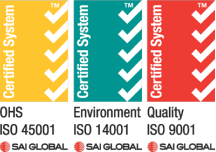A state-of-the-art upgrade to Wagners CFT’s R&D testing facilities has dramatically expanded the businesses capacity and capabilities.
Designed to push the boundaries of innovation, the enhanced facility delivers unparalleled safety, efficiency and flexibility empowering the company to lead cutting-edge research and accelerate the development of breakthrough products.
Ensuring the upgrades ran smoothly were Wagners CFT Technical Lead, Ali Mohammed and Research and Development Technician, Tim Griffin.
“The initial motivation for starting the R&D area upgrades came from the need to align our facilities with the evolving demands of product development,” Dr Ali Mohammed said.
“While smaller upgrades had already been taking place to support new product lines, the introduction of the large filament wound poles, as the next stage of the current pultruded poles, was the key trigger,” Dr Mohammed said.
“Their scale and testing requirements drove the need for a major transformation and overhaul of the testing facility, beyond the incremental improvements made previously,” he said.
“These upgrades were chosen to not only meet the load requirements of upcoming large filament wound poles but to also provide the flexibility and capacity to support future product development, prototypes, and evolving testing needs.”
“By enabling the testing of larger and more complex structures, it allows us to replicate real-world conditions more accurately, leading to more reliable and actionable data.”
“At the same time, the upgraded facility incorporates more efficient workflows and safer testing methods, reducing setup time and minimising risks during testing.”
“Together, these improvements strengthen our ability to support current R&D initiatives and provide the flexibility to undertake more ambitious, innovative projects in the future.”
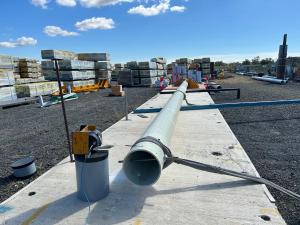 Pictured – The old R&D area ready for a cantilever test on an FRP utility pole.
Pictured – The old R&D area ready for a cantilever test on an FRP utility pole.
With the Engineering team at the helm, the upgrade project thrived on teamwork and innovation.
“The Engineering team has been the lead group in developing the design of the upgraded systems,” Dr Ali Mohammed said.
“Our engineers and R&D technicians worked side by side to blend technical expertise with hands-on experience,” Dr Mohammed said.
“This close collaboration not only ensured the most effective test setups and procedures but also fostered a strong team spirit, where ideas flowed both ways and solutions were created together,” he said.
“Overall, it’s been a large consultation process where everyone who has been involved in R&D has had input to bring the idea to life,” Tim Griffin said.
“Wagners Engineering Solutions have also been extremely helpful with any fabrications that are outside our scope here at CFT,” Mr Griffin said.
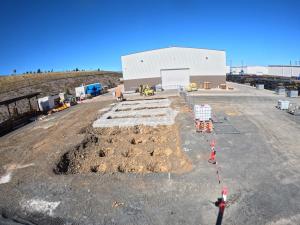 Pictured – The beginning of construction on the new R&D area.
Pictured – The beginning of construction on the new R&D area.
Driven by the constraints of the old setup, the new design improves safety, efficiency and testing capabilities.
“The old facility needed upgrading for a number of reasons, one being a large portion of the old setup was mostly made up of older jigs that were subject to years of modification,” Tim Griffin said.
“The hydraulic winch from the old pole cantilever setup was mounted on three 2.5t blocks of concrete and was always very time-consuming to disassemble and move into a position that is proportionate to the pole being tested,” Mr Griffin said.
“Our engineering team developed a track mounted system for a hydraulic winch that can safely be moved into position within minutes, furthermore it will include an additional function to move dynamically as the pole being tested deflects under load,” he said.
“The new pole cantilever test setup (pole bend test) gives us the capacity to test lengths of up to 23 metres, previously we were limited to a maximum length of up to 16 metres.”
“The old load frame was entirely above ground which made loading large samples along with the very heavy fixtures inherently unsafe and difficult.”
“As the new setup is all at ground level, samples can be loaded safely and with ease by simply driving on and off with a forklift. This will result in a much faster turnaround in routine tests such as pole cantilever and 4-point bending.”
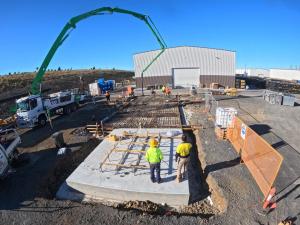 Pictured – A cement pour occurring at the new R&D area during construction.
Pictured – A cement pour occurring at the new R&D area during construction.
The upgrades boost testing capacity for larger poles and realistic load conditions.
“The main technical upgrades focus on significantly increasing the testing capacity of the facility, both in terms of load & scale, with ease of access,” Dr Ali Mohammed said.
“The upgraded systems will allow cantilever/horizontal bending tests up to 2,000 kN·m to accommodate large poles with 20 metres above ground height subjected to 100 kN tip load,” Dr Mohammed said.
“It will also allow vertical testing capacity up to 1,000 kN, accommodating poles up to 20 metres above ground length and large-scale poles Ackerman test capability, which will be introduced as an addition in the coming weeks,” he said.
“These upgrades ensure the facility can support the next generation of large-scale pultruded and filament wound poles, providing the capability to test products at full size under realistic loading conditions.”
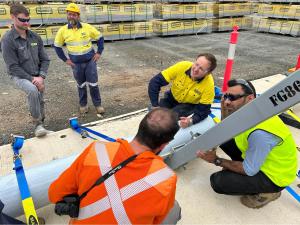 Pictured – An FRP utility pole and crossarm being assessed after a test at the old R&D area.
Pictured – An FRP utility pole and crossarm being assessed after a test at the old R&D area.
Site limitations and tough ground conditions shaped the design and construction of the new test setup.
“A key constraint was the tight footprint of the R&D area, requiring an efficient layout that accommodates all planned tests,” Dr Ali Mohammed said.
“We also designed the setup to reuse existing jigs and hardware where possible, maximising space and resources,” Dr Mohammed said.
“One of the main challenges has been boring into the rock, which is always demanding,” he said.
“During excavation, some of the top soil collapsed, requiring slight modifications to the foundation design.”
“As a result, the bored piers ended up larger than originally intended, which in turn led to an increase in the spacing between them.”
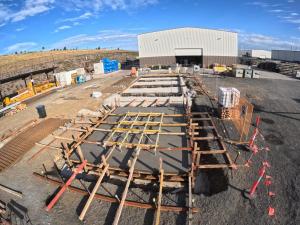 Pictured – The new R&D area half way through construction.
Pictured – The new R&D area half way through construction.
While the test setup has evolved, many tools, procedures and training processes will carry over with minimal changes.
“The tools and systems we had previously for routine testing are interchangeable with the new setup,” Tim Griffin said.
“For our proceduralised tests such as cantilever and 3 & 4 point bend tests, the procedures will be amended to suit the new setup,” Mr Griffin said.
“Removing and cutting up a pole that has been tested to failure will remain the same,” he said.
“Non-proceduralized tests are always assessed on a case-by-case basis as they are generally at the discretion of the Engineer and/or Technician undertaking the test, which in itself can range from a compilation of notes and ideas to a well-structured test plan.”
“Unless the scope of any given test changes significantly, training will simply become a restructured version of what we already have in place for proceduralised tests.”
“As our test capacity grows, so will the procedures and training that go with it. This will mostly be developed in-house.”
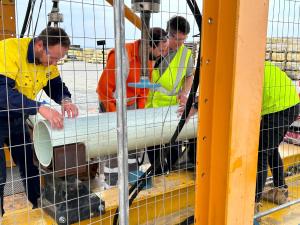 Pictured – A test being conducted on an FRP utility pole at the old R&D area.
Pictured – A test being conducted on an FRP utility pole at the old R&D area.
Through its participation in the upgrades, led by Professor Peter Schubel, Executive Director, Institute for Advanced Engineering & Space Sciences, UniSQ bridges the gap between research and industry to fuel innovation.
“UniSQ is a key collaborator, building on the ongoing research projects, long-standing history and close working relationship with Wagners,” Dr Ali Mohammed said.
“Their involvement ensures that the upgraded facility aligns with both industry and research needs,” Dr Mohammed said.
“It will provide students and researchers the access to world-class infrastructure, enabling them to carry out advanced testing to support both academic and applied research,” he said.
“This not only contributes to their learning and growth but also strengthens the link between industry and academia, fostering innovation that benefits both sectors.”
“The long-standing collaborative partnership between Wagners and UniSQ continues to work towards the development of new initiatives, IP generation and commercialisation. This relationship also provides a pipeline of talented engineers to support workforce growth,” Prof Peter Schubel said.
“The addition of the combined Wagners/UniSQ pole testing facility is a great example of industry and academia collaborating to develop common use infrastructure to grow the manufacturing base in Australia,” Prof Schubel said.
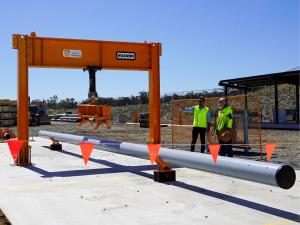 Pictured – The new R&D testing equipment featuring the Wagners and UniSQ logos.
Pictured – The new R&D testing equipment featuring the Wagners and UniSQ logos.
With construction complete, the facility is now operational and poised for cutting-edge testing and innovation.
“Construction was completed and proof loading carried out in August 2025, with the test facility now fully operational,” Dr Ali Mohammed said.
“The next big improvements will include installing the loading winch on a track and integrating the Ackerman test setup within the newly developed testing facility by the end of the year,” Dr Mohammed said.
“When it comes to innovation, the opportunities are virtually limitless. In the near term, this upgraded facility will directly support the development of next-generation utility poles, including the ability to conduct static testing on large-scale poles,” he said.
“It will also allow us to simulate bushfire conditions on poles while they are under load, providing valuable insights into performance and resilience.”
“Over the next five years, this capability will drive more advanced testing, product improvement and industry-leading innovation.”
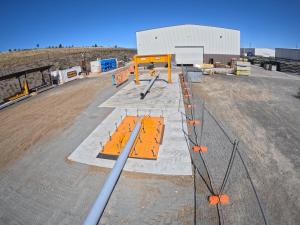 Pictured – The finished upgrades on the new R&D area.
Pictured – The finished upgrades on the new R&D area.
With product demand surging, upgrading Wagners CFT’s in-house testing capabilities is a timely and crucial move.
“Now is the right time to invest in these upgrades due to the rapid growth of the utility pole market in Australia, which is driving increasing demand for high-performance, reliable products,” Dr Ali Mohammed said.
“Additionally, these improvements enable Wagners CFT to meet new supply commitments to major utility companies, ensuring we can deliver on both volume and quality requirements,” Dr Mohammed said.
“Investing at this stage positions the facility to support current projects while also providing the flexibility and capacity needed for future growth and innovation in the sector,” he said.
“Wagners CFT has always been at the forefront with its testing capabilities, which is especially critical in the FRP composites sector where design capacities and performance are largely determined through experimental data.”
“These upgrades further reinforce that leadership by introducing a one-of-a-kind testing capacity in Australia, including the Ackerman test setup for utility poles under load and bushfire conditions.”
“This positions us ahead of competitors by offering unique, world-class testing that directly supports innovation and reliability in the market.”
If you have a product you want tested at Wagners CFT’s world-class facilities, complete the Contact Us form on the website – https://www.wagnerscft.com.au/contact-us/
To learn more about Wagners FRP products, watch our webinar ‘Its What’s Inside That Counts’ – https://www.youtube.com/watch?v=r_zJAddUOac&t=2471s
If you are a first-time FRP user, read ‘Contractor embraces FRP – reducing risk, seizing opportunities and boosting business resilience’ to find out how a Victorian contractor challenged the status quo and up-skilled his team to be able to construct engineering projects from modern building materials – https://www.wagnerscft.com.au/contractor-embraces-frp/
Thank you to the site (specifically Shed D and Yards Persons) for their patience and assistance in coordinating the civil works process since it began – Tim Griffin

